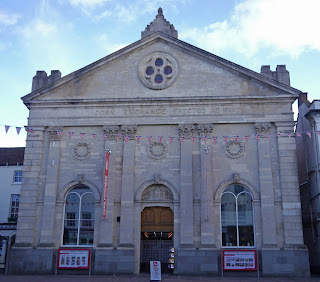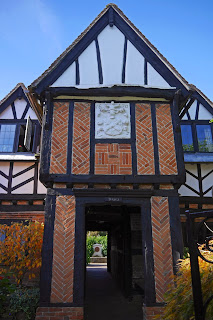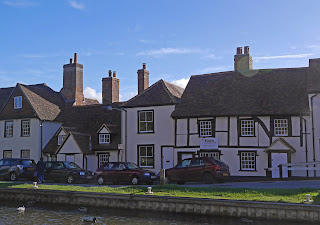The Town Hall
I know Newbury reasonably well, but I was surprised to discover in a book on the subject that there are a number of groups of almshouses, a special interest of mine. I decided to do a town walk and developed my own route to take in as many almshouses as I could identify. I decided to start at the Clock Tower at the top of Broadway. It dates only from 1929 - I would readily have believed it was Victorian.
Down Broadway, into Northbrook Street, with many impressive 18th and 19th century facades above the shopfronts, over Newbury Bridge and left into Mansion House St towards the Market Place. On the right is the Municipal Building of 1908, which replaced the old Mansion House when the road was widened. The Town Hall itself dates from 1876-81 and is reminiscent of Waterhouse's one in nearby Reading.
The Market Place leads to the Wharf which boasts the timbered-framed Cloth Hall of 1626-7, the "most interesting house in Newbury" according to Pevsner, and now the town Museum. Sadly for me it is currently shut for refurbishment.
In the Market Place itself the other really notable building is the Corn Exchange of 1861. There are also some nice old pubs.
I left the Market Place via Cheap St and passed the former public library of 1902, now a restaurant. It has some very pleasing art nouveau style glass panels in the windows.
Then along Market St and into Bartholomew St, with the massive Oddfellows Hall of 1886 in Craven Road to the right. It is now flats.
Further along Bartholomew St there is the empty Eight Bells pub, which dates back to the 16th century.
At the junction with Pound St, Argyle St is over on the right and this contains a remarkable group of buildings. On the left is St Bartholomew's Hospital, an almshouse originally founded in the 12th century, but whose current buildings date from 1698. It looks a little worse for wear and older photos show a clock above the stone plaque announcing its name.
Opposite is a building called St Bartholomew's Manor House. Pevsner says that the facade dates only from 1927-8, but that the house behinds goes back to Tudor times.
Further along on the right are the Essex Wynter Almshouses. Originally a farm, they became the Phillip Jemmet almshouses in 1670 (and his initials can be seen over the door) and were reconstructed (having become derelict) in 1929.
Round the corner are the Upper Raymond Almshouses of 1826. They consist of a plain brick terrace, but with dramatically large chimneys, gothick windows and a curious shallow stone arch stuck on to the centre of the block.
Nearby are the very plain Lower Raymond Almshouses, bearing the date 1796. Another range at right angles to this one was destroyed in by bombing 1943.
The contrast between these two groups of almshouses is interesting. Alsmshouses were effectively an early form of social housing, but they almost have a higher level of architectural ambition than is found in workers' cottages of any period and housing estates of the Victorian or later periods. The Upper Raymond ones fit this pattern, but the Lower Raymond ones don't. I wonder why.
I retraced my steps towards the town centre, this time taking Bartholomew St to reach St Nicholas church. This fine Perpendicular Gothic church dates from about 1500-32.
Now long West Mills, with a very pleasing collection of houses of various ages beside the Kennet and Avon canal, some of which were once almshouses.
I walked along the other side of the stream to reach Newbury Lock and another view of the church. This marked the effective end of the walk.
Conditions: bright and sunny, with odd bits of cloud.
Distance: about 3.5 miles.
Rating: four stars.















No comments:
Post a Comment